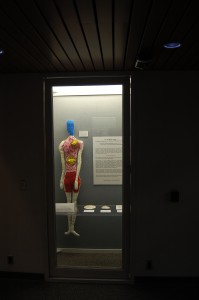“For the Brides of Ed: An Integrated Approach to Treating Eating Disorders: Art Therapy, EMDR and Prescriptive Art,” is the title of the innovative exhibit currently on display at the Edward G. Miner Library in the UR Medical Center. Running through Oct. 31, this exhibit was created by prescriptive artist Nancy Gershman and art psychotherapist Lauren Lazar Stern.
It looks at the primary relationship with eating disorders and the women and girls suffering from them. The exhibit exposes visitors to a unique and integrated approach to treating this population.
“We felt that eating disorders are a big enough scourge and wanted to raise awareness that treatment and recovery are possible,” Gershman said. “Eating disorders can start with something insignificant or traumatic, but once it gets going, it’s like a rolling avalanche that eventually consumes them.”
Art therapy is just the first stage of treatment in Stern and Gershman’s pioneering approach. Visitors can see client artwork, including giant stuffed dolls that express the client’s feelings towards her own dysmorphia and masks created before and after recovery.
Art therapy exercises are likewise included, shedding light onto how much obsessive thinking there is in relation to thoughts about family, work, and school.
Also featured in the exhibit are photographs of the brain-body processing equipment used in the second stage — EMDR (Eye Movement Desensitization Reprocessing). By stimulating the visual, auditory, and tactile senses, Stern hopes to “desensitize” the client’s traumatic memory that originally triggered the “ED.” The second step is to reprocess and resolve these early memories that impair their ability to enjoy life.
“Until these distressing events are reprocessed, life can be extremely rocky and unpleasant,” Stern said. “Freedom from ED comes after engaging with not one or two, but all three aspects of the approach.”
The final stage of recovery involves Gershman’s “prescriptive art,” a term she coined to distinguish her meaning-making artwork from art therapy which she describes as a means to express “the obsessive thinking and the distress but also to rediscover what brought them joy before ED and reinforcing the lessons learned through therapy.”
“[Eating disorder clients] tend to see life through a negative filter. Because they can’t write their own prescriptions,” Gershman said. “My job as a prescriptive artist is to create a positive self-belief story that the brain will buy into. Working with symbols, metaphors and sensory imagery… this is the language the emotional brain understands.”
The prescription takes the form of a “Healing Dreamscape”— a digital photomontage shaped by repurposing a client’s photographs into a story consensually shaped with the client during an interview process. The Dreamscape — as an 8 x 10 print or wallet-sized – focuses the client on a hopeful and positive scene that they will keep and refer to, ensuring recovery and avoiding relapse.
The exhibit presents several kinds of Dreamscapes. A “Guardian Dreamscape” depicts the relationship between the client and a person dear to them, typically a past provider of comfort. A “Suggestive Dreamscape” visualizes the client taking recommended steps, such as eating healthy and sleeping deeply.
In one particular Dreamscape, Sally, who is fighting anorexia, feeds her overweight and under-exercised husband a nutritious maki roll while he feeds her rich lasagna. All this is happening in the middle of an ocean where he practices his favorite sport -— fishing — as if it were a cardio exercise. This “Promissory Dreamscape” depicts the couple’s promise to support one another in a time of need.
The exhibit’s guest book is a testament to the positive dynamic at work between practitioner and client, attendees describing the show as “evoking,” “touching,” and “liberating.”
“Not only is it intriguing mixed media, but it also shares a cutting-edge modality for those who suffer from eating disorder,” Susan Andersen, administrator of the URMC libraries and technologies, said.
One important message Gershman and Stern drove home is “the value of visiting the exhibit if you suspect a friend or a member of the family to have an eating disorder.
“Seeing the young girls and women in the exhibit as role models, finding their bliss again can be a real game changer,” Gershman said.
Pinera is a member of the class of 2016.


